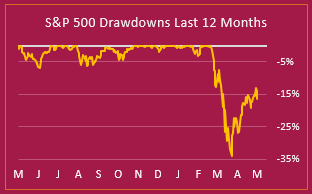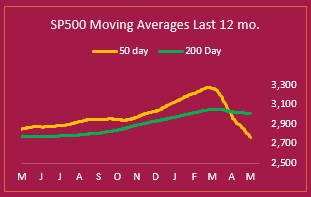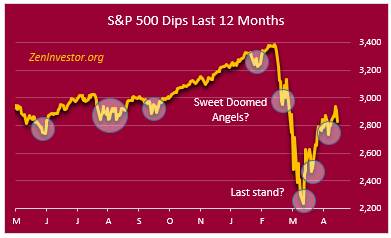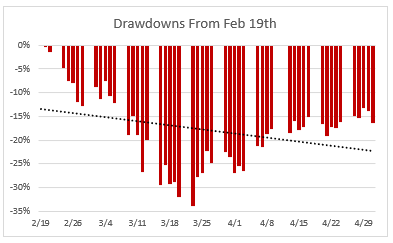The Narrative
The narrative has flipped from 'this is really bad' to 'let's reopen the economy.' We've moved from pessimism to optimism. And based on the stock market, investors appear to be buying into the optimistic narrative.
Cullen Roche, from Pragmatic Capitalism, made a good case for optimism in an opinion piece on Marketwatch. He argues that the stock market is forward-looking, and I agree with him. But he takes things a little too far when he argues that the market is correctly predicting record corporate profits in 2021 and 2022. I'm not that optimistic.
I think it's more likely that the pandemic, the recession, and the bear market will be with us for longer than optimists like Mr. Roche would have you believe.
I base my argument on my own case. I'm in favor of opening things up, but I will be slow to join the party. I will avoid crowded stores, theaters, restaurants, casinos, airlines, concerts, cruise ships, sports arenas, and any other places where social distancing will be hard to maintain.
My question to Mr. Roche is this. How will corporate America return to record profitability in 2021 when customers are still wearing masks and gloves, or avoiding their businesses altogether? And how quickly will we return to full employment? I don't think he's wrong, I just think he's early.
Let's go through the charts
Last week we had two good days, two mediocre days, and a bad day on Friday. The net result was a push - down 0.21% for the week. What I think is significant is the stalling of upward momentum.
Next we have drawdowns. After dropping like a stone by 34%, the market has recovered half of that loss. Where to next? It's anybody's guess, but I'm not ruling out a retest of the lows.
Next we have the dreaded Death Cross. The market on a daily scale looks pretty good, but on a moving average scale it looks pretty bad.
Next we have the dips, and those who are buying them. It takes courage to buy the dips in a market like this, and the first to step in and buy were what I've called the Sweet Doomed Angels. These are the folks who buy every dip, and with the exception of late 2018 they have been handsomely rewarded almost immediately.
But this time around they are under water. The dip buyers who waited until mid March are in much better shape. They made a "last stand" and they are up substantially. As we move higher up the rally track it's getting harder for the dip buyers to commit more capital. I think they know that we've come a little too far, and too fast. I further think they are taking a break to reassess their strategy.
Lastly, we have the trend of market drawdowns since the peak on February 19th, 2020. It's clear from the chart below that the market is in recovery mode, but the trend-line is still quite negative.
This is just another way to see the market trend, and it doesn't mean very much when looked at in isolation. But when combined with the other charts above, it takes on more significance. Namely that we are not out of thiss mess yet, and caution should be exercised by dip buyers and optimists.
Final Thoughts
The most frequently asked question I get from clients, subscribers, and readers is this: "Is it time to get back into the market?" The only honest answer is "I don't know." But I'm advising clients to limit their exposure to equities until we know more about how this reopening is going.
While it's true that the stock market is forward-looking, I'm not at all sure that 2021 will usher in a return to anything resembling normal, and record corporate profits. What's more likely is a market that lurches between optimism and pessimism as we learn more about where we may be headed next.
I have other ideas to share, and I'm going to put them in my upcoming Monthly Intelligence Report. Check it out here.





